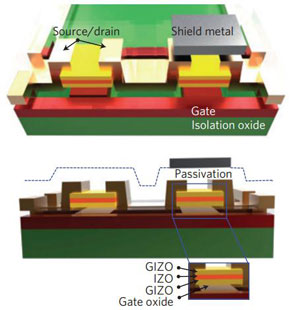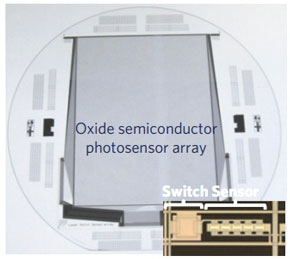| Mar 05, 2012 |
Transparent oxide-photosensor for contact-free interactive displays
|
|
(Nanowerk News) The oxide semiconductor transistor is a promising candidate for the next generation of display screens because of its high performance and high transparency associated with its wide band-gap. These properties make the transistor suitable for a range of exciting transparent display applications, e.g. new smart window technology in cars and homes.
|
|
Interestingly, although it is transparent, the oxide semiconductor can also detect visible light due to the presence of oxygen vacancies in the sub-gap states, suggesting possible transparent photosensors for visible light applications. These properties allow an oxide-photosensor integrated with a transparent display to be created, however, ionized oxygen vacancies under illumination can also lead to persistent photoconductivity (PPC). PPC causes the semiconductor material to remain conductive for hours/days, leading to low frame rates, the rate at which an imaging device produces unique consecutive images.
|
  |
| Left: Schematic of a sensor pixel incorporating an inverted staggered switch-transistor and photo-transistor. Right: Photograph of the fully fabricated photosensor pixel array. The inset shows a photosensor composed of one photo-transistor and one switch-transistor.
|
|
LCN researcher, Sungsik Lee in collaboration with Prof. Arokia Nathan, University of Cambridge, and Samsung Advanced Institute of Technology (SAIT) showed in a recent study (see paper in Nature Materials: "Gated three-terminal device architecture to eliminate persistent photoconductivity in oxide semiconductor photosensor arrays") that a transparent active-matrix photosensor array, that can operate at high frame rates and which has potential applications in contact-free interactive displays as shown in the figure above (right), had been integrated.
|
|
The study also found that persistent photoconductivity (PPC) can be eliminated by a short-duration voltage pulse to these devices, inducing electron accumulation and accelerating their recombination with ionized oxygen vacancy sites.
|


